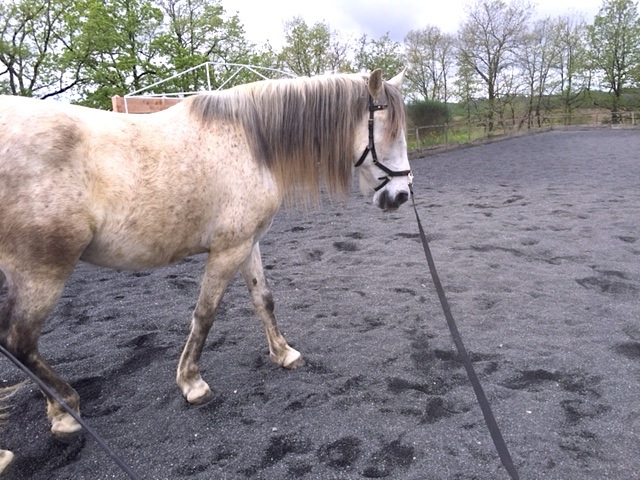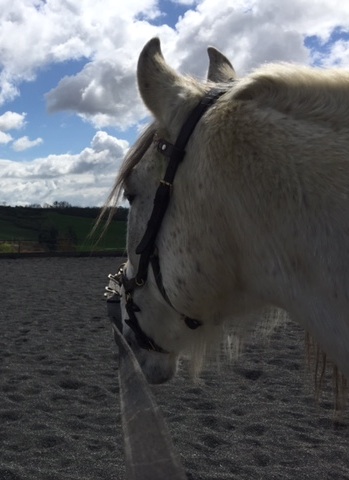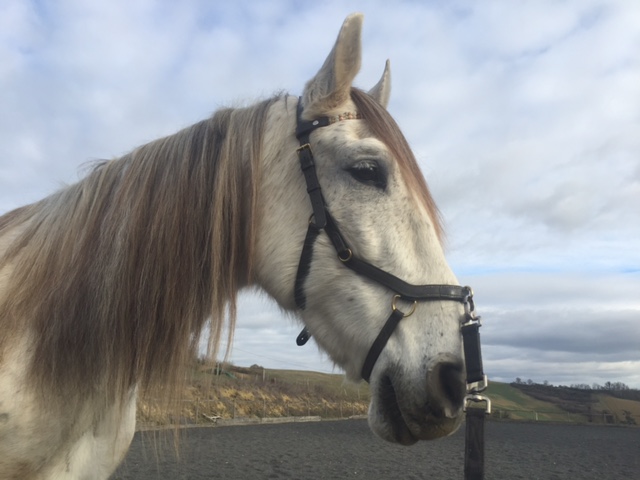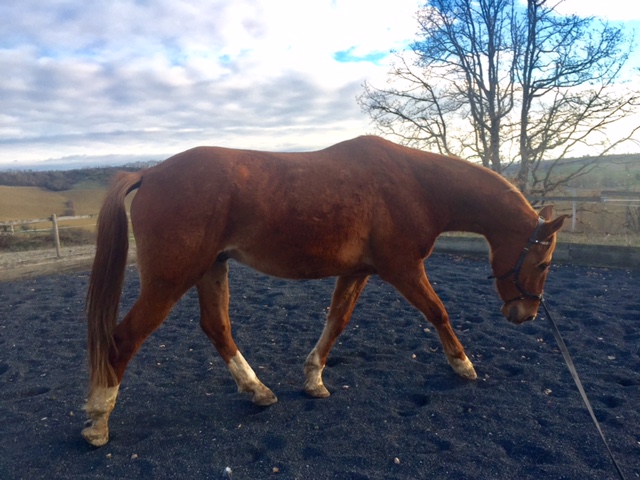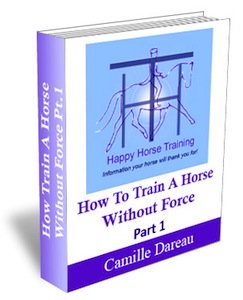| Back to Back Issues Page |
 |
|
Breaking the ice January 22, 2017 |
Breaking the IceIt's been an interesting experience picking up work with Habanero again after my time off since having my baby girl, and his (shorter) break since Camille left. Habanero has had a troubled past in Spain before his current owner rescued him. He came to HHT last year for a holistic rehabilitation process, combining a natural lifestyle in a herd environment with gymnastic training, plus whatever energy work he needs along the way. The work I had done with him last year was focused on gymnastic lunging to address some major issues that needed to be resolved before starting riding work. These included a basic distrust of people, a strong crookedness pattern including difficulty bending and a pelvic unlevelness, a hollow posture and a lot of general resistance to going forward.
Early work on the lunge last year, with a lot of resistance to going forward and an undeveloped posture. I had spent a lot of time building trust with him initially by respecting his boundaries - doing a lot of simple in-hand work giving him time to relax without making demands. Although his previous trauma associated with work was obvious, at this stage it was being expressed as certain repetitive habits such as clacking his teeth together, nipping at me, and switching direction on the lunge. Energetically he seemed hardened and resistant, but he expressed little tension outwardly. As he started to loosen up and unwind in the lunging work, and to realize that he could move forward without restraint, he became more energetic in his habit of rapidly changing direction, and very occasionally he would try to bolt off at a gallop. The first time I took him to the arena this year his tension was all out on the surface! Despite taking the time again to walk calmly around the arena, stopping for 'threat assessment' whenever he needed to, he was like a live wire. He repeatedly tried to bolt out of nowhere and almost over the top of me!
What I wanted to talk about in this newsletter is how I reacted to that tension, because it's such an important thing to be aware of with horses. Reacting in the wrong way is the easiest thing to do in the world and is totally natural, but it can get you into a real vicious circle, ruining both your own confidence and the horse's trust in you. People say that having a baby causes hormonal changes that make you more aware of danger, and during the sessions when Habanero was expressing this tension I think it's true that I resonated particularly strongly with it. This made
me more aware than usual of the gulf that separates the two ways we can react to tension.
Fear Separates, Trust ConnectsWhen I could sense the tension in Habi as I was leading him round the arena, if I let it creep into myself and grow to the point I was just waiting for him to bolt off and possibly barge over the top of me in the process, the effect it had on me was to make me want to distance myself from his body, coming towards his head, holding him on a short line, or pushing him away with the whip. The feeling reminded me of when there's tension between people in a social situation and no-one talks. When I let the tension between me and Habi take over it also completely blocked the communication between us.I knew the only real solution was to 'break the ice' . Instead of pulling away, I had to make contact with his body. I let the lunge line out longer, and moved back beside his rib-cage into the position where I could ask him to yield his body away from my with the pressure of my hand against his side. This position is a place of vulnerability for both of us - for me because it would be much easier for him to either kick or run over me, and for him because instinctively the horse's flanks and belly are the most exposed to attack by predators. Coming into this position means that both horse and human have to let their defenses down. When you ask a horse to yield from massaging pressure far back on their side, whether in-hand or with your leg when riding, the yielding causes the diaphragm to relax and release tension. This is a very powerful effect on the emotions, with a direct influence on the limbic brain via the vagus nerve. This is an extract from a fascinating article by Helen Papaconstantinos B.A.(H), R.O.H.P., R.N.C.P. on this subject in humans, but it's just as relevant to horses: "The vagus nerve is the 10th cranial nerve in your body. It is a very long nerve running from the hypothalamus area of your brain, chest, diaphragm, and to your intestines. It wraps around your heart and core area (Hara point and solar plexus centre) – areas traditionally considered to be the seat of intuition and compassion. […] One of the key roles that the vagus nerve plays, is acting as the “reset” button after your internal alarm system has been set off – i.e., in response to some type of perceived threat (a stress response). This nerve then communicates with the rest of your body to tell you that the threat is gone and that all of your bodily functions can now return to normal, healing mode." As soon as Habi started yielding, the tension evaporated, as if the physical contact between us had earthed an electrical charge. The lines of communication were open again, just like when someone breaks the ice in an encounter. It's an amazing transformation. Once I asked for it, his ability to yield sideways in alignment and to soften onto
the bend as a result was actually much improved from last year.
When I let him out onto the lunge, he went straight into a nice posture of longitudinal stretching, something that had been very hard-won last year. It's always a nice surprise that horses don't lose the postural progress you make with them through gymnastic training, even after extended rest periods.
Keeping The Connection When RidingThe same dynamic that I've described here also applies when you're riding. If you feel tension in yourself and/or the horse, you have a choice of how to react.If you allow your instinctive reaction to take over it will make you want to separate yourself from the horse's body - to lean forwards, lift your weight out of your seat and take your legs out of contact with his/her sides. It will also make you want to tighten the reins and hold on more. All of these reactions increase the horse's tension because you are effectively abandoning them at the same time as stopping their natural flight response to danger. At the same time these reactions make your position much less secure as well as breaking your lines of communication. You can change this vicious circle into a positive one if you choose the reactions of trust, which are those of physical contact and connection. - Keeping your center of gravity dropped down into your seat not only makes you much more secure but also makes your horse feel more secure and balanced. - Keeping your legs on with a gentle massaging contact (not gripping of course!) allows you to keep 'talking' to the horse's body and to maintain that powerful de-stressing yield response in the diaphragm. - The more you can keep your contact soft and giving, the less the horse will feel trapped and want to run to escape. Of course doing all these physical things goes along with your ability to master your state of mind and to choose to be calm, confident and trusting. You could say this needs to come first, but sometimes just making yourself do the right thing physically can be enough to get a little relaxation from the horse, which in turn allows you to relax, breaking into the positive circle. That's what I did when I made myself get back into the right place with Habanero and ask him to yield - it didn't feel very comfortable but it was all it took to get our
mutual trust back in operation.
Habi was totally relaxed the following session, even though his friend Ouhmia didn't come down the track next to the arena to accompany him as she usually does.
Habi has integrated very well into the herd now. When we first introduced him he displayed a lack of respect for the other herd members' boundaries. The herd has an amazing power to, over time, make horses more civilised, sociable and confident. This creates great resources for healing damaged relations with people.
Getting to the Root of TensionIt's always important to understand and address the causes of tension if it manifests in a horse you're working with.Very often it comes from a non-holistic lifestyle, where horses spend too much time confined to a stable, and even when they are turned out they do not have social stimulation and security of a herd environment. Tension can also be triggered by an unnatural diet, and of course by a whole range of physical issues from dental or foot problems to back pain. Horses, like Habi, often have causes of tension in the was they've been treated in the past, which can range from a simple lack of trust from insensitive handling to trauma from abusive treatment. You also have to make sure that your training methods are not a source of tension in themselves of course. Every horse has a different level of sensitivity, so it's about learning to grow your awareness of your horse's energy state in each moment. It's extremely easy to mistake a dissociated, switched-off horse for a calm, accepting one. Gymnastic training methods, applied slowly and sensitively, are a very good way of starting to soften this kind of shell and bring things out to the surface to be healed.
Lulu is a great example of a horse who had a lot of tension associated with the arena which he has now totally let go of. The first time I worked him this year after a long break he was totally relaxed and happy about it, and he worked beautifully!
Just Click here to go to the HHT group page, and then click on the 'join group' button at the top right of the page.
Sharing the Holistic Message
If you enjoy the Happy Horse Training website, and you find the information on it useful, please help us to share it by clicking on the Facebook 'like' and 'share' buttons that are on each page (you can also share this newsletter by clicking on the symbol above). Any other way you can pass the site on to friends and colleagues, for example via discussion forums, is also greatly appreciated. You can also sign up to our RSS feed (blog) to be kept up to date with new ideas, pages and other information that we post there. Just click on the box that says 'subscribe to this site' at the left of each page. The equestrian world is one dominated by traditionalist ideas and conventions, but we would like to help inform the growing minority of horse-owners who want to make their horses happier with progressive and holistic methods.
Happy Horse Training now has over 100 pages exploring many different areas of holistic equitation. Do have a look through our site plan to find the subjects and categories that interest you.
Available from HHT:
The Gymnastic Rider eBook 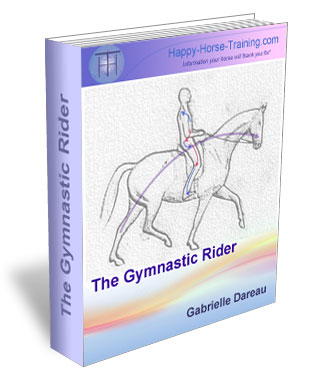 Available exclusively from HHT, a unique and comprehensive guide to practical rider biomechanics. This professionally produced eBook takes the rider through the process of developing their body in the specific way that brings the horse's movement into harmony and balance, without force and constraint.
Available exclusively from HHT, a unique and comprehensive guide to practical rider biomechanics. This professionally produced eBook takes the rider through the process of developing their body in the specific way that brings the horse's movement into harmony and balance, without force and constraint.
The information in this book, including over 55 000 words, represents what we would normally pass on in a minimum of 12 specialist lunge lessons, focusing on each part of the position and its influence on the horse, with a value of at least €450. The Gymnastic Rider is available for only €29.99. Click here for full details, and to download the 15-page introduction to the book for free.
How to Train a Horse Without Force
eBook With your purchase you will receive a free bonus supplement on Horse Trauma - cutting edge insights on this subject that up until now have mostly been applied only to human trauma. This supplement shows how to recognise, avoid and deal with horse trauma, which is much more common that we realise. These two e-books - How to Train a Horse Without Force and Horse Trauma comprise more than 75 thousand words and are richly illustrated. They are available for only 19.99 Euros (around $26). Click here for more details.
|
| Back to Back Issues Page |
